- Home
- Jared Diamond
The Rise and Fall of the Third Chimpanzee Page 11
The Rise and Fall of the Third Chimpanzee Read online
Page 11
The first study involved great blue herons and great egrets at Hog Island, Texas. In these species the male builds a nest and stays there to court visiting females. Eventually a male and female accept each other and copulate about twenty times. The female then lays eggs and goes off to spend most of the daylight hours feeding, while the male remains to guard the nest and eggs. During the first day or two after pairing, the male often resumes courting any passing female as soon as his mate leaves to feed, but EMS does not result. Instead, the male’s halfway-unfaithful behaviour seems to constitute ‘divorce insurance’ that reserves a back-up mate for him in case his own mate deserts (she does desert him in up to twenty per cent of the pairings reported). The passing ‘back-up’ females pursue the courtship out of ignorance. They are seeking a mate and have no way of knowing that the male is already mated, until his spouse returns (which she does at frequent intervals) and drives them off. Eventually, the male gains complete confidence that he will not be deserted, and he ceases to court any passing females.
In the second study, of little blue herons in Mississippi, behaviour that might have originated as divorce insurance took a more serious turn. Sixty-two cases of EMS were documented, mostly between a female on her nest and a male from the neighbouring nest while the female’s mate was busy finding food. Most females initially resisted but then ceased resisting, and some females engaged in more EMS than marital sex. To reduce his own risk of being cuckolded, the adulterous male did his feeding as quickly as possible, returned often to his own nest to guard his mate, and travelled no further than neighbouring nests to seek EMS. EMS was usually timed to occur when the chosen female had not yet completed egg-laying and could still be fertilized. However, adulterous copulations were quicker than marital copulations (eight versus twelve seconds), hence possibly less effective at fertilizing, and nearly half of all nests involved in EMS were subsequently abandoned.
Among herring gulls in Lake Michigan, thirty-five per cent of mated males were observed to engage in EMS. This percentage is nearly the same as the value of thirty-two per cent reported for young American husbands in a study published by Playboy Press in 1974, but there is a big difference between gulls and humans in female behaviour. Whereas Playboy Press reported EMS for twenty-four per cent of young American wives, every mated female gull virtuously rejected adulterous male advances and never solicited the neighbouring male in her own mate’s absence. Instead, all cases of male EMS involved unmated female gulls practising PMS. To decrease his own risk of being cuckolded, the male spent more time chasing intruders away from his nest when his mate was fertile than when she was not fertile. As for how the male induced his mate to remain faithful during the time that he was off seeking EMS, his secret – like that of some married men similarly pursuing a mixed reproductive strategy – consisted of feeding her diligently and copulating often whenever she was receptive.
Our final set of rigorous data involves snow geese breeding in Manitoba. Just as I explained in the case of little blue herons, EMS in snow geese mainly involves a male approaching an initially resisting female on a neighbouring nest in the absence of her mate. The mate’s absence is usually due to the fact that he himself is off seeking EMS. It may seem as if the male thereby loses as much as he gains, but a male goose is not so dumb. As long as the female is still laying eggs, her mate remains to guard her. (A nesting female is propositioned fifty times less often in her mate’s presence than in his absence.) Only after the female has finished laying does her mate go off on EMS quests, with his paternity assured at home.
Such bird studies illustrate the value of a scientific approach to adultery. They have revealed a series of sophisticated strategies by which adulterous male birds try to have it both ways, so as to obtain confidence of paternity at home while sowing their seed abroad. The strategies include wooing unmated females for ‘divorce insurance’, as long as one feels unsure of one’s wife’s fidelity; guarding one’s fertile spouse; feeding her copiously and copulating with her often, to induce her to remain faithful in one’s absence; and coveting one’s neighbour’s spouse at a time when she is fertile and one’s own spouse is no longer fertile. However, not even these applications of the scientific method in all its power sufficed to clarify what, if anything, female birds gain from EMS. One possible answer is that female herons weighing desertion of their mates may use EMS to shop around for a new mate. Another is that some unmated female gulls in colonies with a deficit of males may get fertilized by PMS, and then try to rear the chicks with the help of another, similar female.
The chief limitation of these colonial bird studies is that the females often seem to be unwilling participants in EMS. For further understanding of a more active female role, we have no choice but to turn to human studies, riddled as they are with problems of cultural variation, observer bias, and dubiously reliable survey responses.
*
Surveys comparing men with women in various cultures scattered around the world typically purport to find the following differences: men are more interested in EMS than are women; men are more interested than women in seeking a variety of sexual partners for the sake of variety itself; women’s motives for EMS are more likely to be marital dissatisfaction and/or a desire for a lasting new relationship; and men are less selective in taking on a casual female sexual partner than vice versa. For example, among the New Guinea highlanders with whom I work, the men say they seek EMS because sex with their own wife (or even wives, in the case of polygynous men) inevitably becomes boring, while the women who seek EMS do so mainly because their husband cannot satisfy them sexually (for example, because of old age). In the questionnaires that several hundred young Americans filled out for a computer dating service, women expressed stronger partner preferences than men did in almost every respect: intelligence, status, dancing ability, religion, race, etc. The only category in which men were more selective than women was physical attractiveness. After a date the men and women then filled out ‘debriefing’ questionnaires, with the result that two-and-a-half times as many men as women expressed a strong romantic attraction to their computer-selected partner. Thus, the women were choosier, the men more undiscriminating, in their reactions to partners.
Obviously, we are on shaky ground if we expect an honest answer when we ask people their attitudes about EMS. However, people also express their attitudes in laws and in their behaviour. In particular, some widespread hypocritical and sadistic features of human societies stem from two fundamental difficulties that men face in seeking EMS. Firstly, a man who pursues an MRS is trying to have it both ways: he wishes to obtain sex with other men’s wives, while denying sex with his own wife (or wives) to other men. Some men therefore inevitably gain at the expense of other men. Secondly, as we have discussed, there is a realistic biological basis for men’s widespread paranoia about being cuckolded.
Adultery laws provide a clear example of how men have dealt with these dilemmas. Until recently, essentially all such laws – Hebraic, Egyptian, Roman, Aztec, Moslem, African, Chinese, Japanese, and others – were asymmetrical. They existed to secure a married man’s confidence in his paternity of his children, and for no other purpose. Consequently these laws define adultery by the marital status of the participating woman; that of the participating man is irrelevant. EMS by a married woman is considered an offence against her husband, who is commonly entitled to damages, often including violent revenge or else divorce with refund of the bride price. EMS by a married man is not considered an offence against his wife. Instead, if his partner in adultery is married, the offence is against her husband; if she is unmarried, the offence is against her father or brothers (because her value as a prospective bride is reduced).
No criminal law against male infidelity even existed until a French law of 1810, and that law only forbade a married man to keep a concubine in his conjugal house against his wife’s wishes. Viewed from the perspective of human history, the absence or near-symmetry of modern Western adultery laws is a novelty
that only appeared in the last 150 years. Even today, prosecutors, judges, and juries in the US and England often reduce a homicide charge to manslaughter of the lowest degree, or else acquit altogether, when a husband kills an adulterous wife or her lover caught in the act.
Perhaps the most elaborate system to uphold confidence of paternity was that maintained by Chinese emperors of the T’ang Dynasty. For each of the emperor’s hundreds of wives and concubines, a team of court ladies kept records on dates of menstruation, so that the emperor could copulate with that wife on a date likely to result in fertilization. Dates of copulation were also recorded, and as an auxiliary form of record-keeping, were commemorated by an indelible tattoo on the woman’s arm and by a silver ring on her left leg. It goes without saying that equal thoroughness was applied to excluding men other than the emperor from the harem.
Men of other cultures have resorted to less complicated but even more repulsive means of ensuring paternity. These measures limit sexual access to wives, or else to daughters or sisters who would command a high bride price if delivered as proven virgin goods. Relatively mild measures include close chaperoning or virtual imprisonment of women. Similar purposes are served by the code of ‘honour and shame’ widespread in Mediterranean countries. (Translation: EMS for me but not for you; only the latter is a shame to my honour.) Stronger measures include the barbaric mutilations euphemistically and misleadingly termed ‘female circumcision’. These consist of removal of the clitoris or most of the external female genitalia to reduce female interest in sex, marital or extramarital. Men bent on total certainty invented infibulation, suturing a woman’s labia majora nearly shut, so as to make intercourse impossible. An infibulated wife can be de-infibulated for childbirth or for re-insemination after each child is weaned, and can be re-infibulated when the husband takes a long trip. Female circumcision and infibulation are still practised in twenty-three countries today, from Africa through Saudi Arabia to Indonesia.
When adultery laws, imperial records, and coercive restraint still fail to ensure paternity, murder is available as a last resort. The role of sexual jealousy as one of the commonest causes of homicide emerges from studies in many American cities and in many other countries. Usually, the murderer is a husband while the victim is his adulterous wife or her lover, or else the lover kills the husband. The table on the following page gives some actual numbers for murders committed in Detroit in 1972. Until the formation of centralized political states provided soldiers with loftier motives, sexual jealousy also loomed large in human history as a cause of war. It was the seduction (abduction, rape) by Paris of Menelaus’s wife Helen that provoked the Trojan War. In the modern New Guinean highlands, only disputes over ownership of pigs rival disputes over sex in triggering war.
Asymmetric adultery laws, tattooing of wives after insemination, virtual imprisonment of women, genital mutilation of women – these behavioural habits are unique to the human species, defining humanity as much as does invention of the alphabet. More exactly, they are new means to the old evolutionary goal of males promoting their genes. Some of our other means to this goal are ancient ones shared with many animals, including jealous murder, infanticide, rape, inter-group warfare, and adultery itself. Human male infibulators stitch the vagina closed; some male animals achieve the same result by cementing a female’s vagina after copulating with her.
BREAKDOWN OF MURDERS CAUSED BY SEXUAL JEALOUSY IN THE US CITY OF DETROIT IN 1972
Sociobiologists have had considerable success at understanding the marked differences among animal species in the details of these practices. As a result of recent research, it is no longer controversial to conclude that natural selection caused animals to evolve behavioural patterns, as well as anatomical structures, that tend to maximize the number of their descendants. Few scientists doubt that natural selection moulded human anatomy. However, no theory has caused such bitter divisions among my fellow biologists today as the claim that natural selection likewise moulded our social behaviour. Most of the human behaviour discussed in this chapter is considered barbaric by modern Western society. Some biologists are outraged not only by the behaviours themselves, but also by sociobiological explanations for the evolution of the behaviours. To ‘explain’ a behaviour seems uncomfortably close to defending it.
Like nuclear physics and all other knowledge, sociobiology is available for abuse. People have never lacked pretexts to justify the abuse or killing of other people, but ever since Darwin formulated his theory of evolution, evolutionary reasoning has also been abused as such a pretext. Sociobiological discussions of human sexuality can be seen as seeking to justify men’s abuse of women, analogous to the biological justifications advanced for whites’ treatment of blacks or Nazis’ treatment of Jews. In the critiques that some biologists have directed at sociobiology, two fears recur: that a demonstrated evolutionary basis for a barbaric behaviour would seem to justify it; and that a demonstrated genetic basis for the behaviour would imply the futility of attempts at change.
In my view, neither fear is warranted. As for the first, one can seek to understand how something arose, regardless of whether one considers that something admirable or abominable. Most books analysing the motives of murderers are not written in an effort to justify murder, but instead to understand its causes as a way of preventing it. As for the second fear, we are not mere slaves to our evolved characteristics, not even to our genetically acquired ones. Modern civilization is fairly successful at thwarting ancient behaviours like infanticide, and one of the main objectives of modern medicine is to thwart the effects of our harmful genes and microbes, despite our having come to understand why it is natural for those genes and microbes to tend to kill us. The case against infibulation does not collapse even if the practice can be shown to be genetically advantageous to male infibulators. Instead, we condemn it because we hold the mutilation of one person by another to be ethically loathsome.
While sociobiology is therefore useful for understanding the evolutionary context of human social behaviour, this approach still should not be pushed too far. The goal of all human activity cannot be reduced to the leaving of descendants. Once human culture was firmly in place, it acquired new goals. Many people debate today whether to have children, and many decide that they prefer to devote their time and energy to other activities. We shall reach a similar perspective in later chapters for other attributes as uniquely human as our sexuality, including our art and our abuse of drugs. For these activities too, one can identify animal precursors and discern original roles in promoting survival and gene transmission, but these activities also proceeded to take on a life of their own. Hence I claim only that evolutionary reasoning is valuable for understanding the origin of such human practices, and not that it is necessarily the only way to understand their current forms.
In short, we evolved, like other animals, to win the reproduction game. That contest has a single aim, to leave as many descendants as possible. Much of the legacy of that game strategy is still with us. But we have also chosen to pursue ethical goals, which can conflict with the goals and methods of the sexual contest. Having that choice among goals represents one of our most radical departures from other animals.
FIVE
HOW WE PICK OUR MATES AND SEX PARTNERS
Most humans are choosier about their sex partners than are the (other two) chimpanzees. By what criteria do we select our spouse or bedmate, and how does each of us develop our individual standard of beauty?
*
ONE EVENING, WHILE I was camping with some New Guinea men of the Foré tribe, the conversation turned to women and sex, and my Foré friends proceeded to explain to me their tastes:
The most beautiful women are Foré women. They have gorgeous black skin, thick, dark frizzy hair, full lips, broad noses, small eyes, a nice smell, and perfectly shaped breasts and nipples. Women of other New Guinea tribes are less attractive, and white women are unspeakably hideous. Just compare your white women with our women to see why –
white skin like a sick albino’s, straight hair like strings, sometimes even hair coloured yellow like dead grass or red like a poisonous snail, thin lips and narrow noses like axe blades, big eyes like a cow’s, a repulsive smell when they sweat, and breasts and nipples of the wrong shape. When you get ready to buy a wife, find a Foré if you want someone beautiful.
Among the reasons I did not follow that advice was that I happen to find those ‘unspeakably hideous’ women attractive. But then I was conditioned by my own society’s ideals, just as my Foré friends were by theirs. Darwin commented that every people he knew about – Chinese, Hottentots, black Africans, Fijians, and others – measure beauty by their own appearance. Are there really no universal rules of human beauty and sex appeal? If not, do we inherit our particular taste in marriage partner through our genes, or do we learn it by looking at other members of our society? How, really, do we pick our sex partners and spouse?
It may be surprising to realize that this problem is one that arose anew during the evolution of the human species – or at least became much more important for us than for the other two chimpanzees. As we saw in Chapter Three, our familiar human mating-system, based ideally on couples maintaining on-going involvement, is a human innovation. Pygmy chimps are the opposite of sexually selective; females mate in sequence with many males, and there is much sexual activity between females and between males as well. Common chimps are not so completely promiscuous – a male and female may sometimes go off and ‘consort’ with each other for a few days – but they still rank as promiscuous by human standards. However, humans are much more selective sexually, since rearing a human child is difficult (at least for hunter-gatherers) without a father’s help, and since sex becomes part of the cement that differentiates co-parents from other men and women frequently encountered. Choosing a mate or sex partner is not so much a human invention as a reinvention of something practised by many other (nominally) monogamous animals with lasting pair-bonds, and lost by our chimpanzee-like ancestors. Those choosy animals include many bird species, plus our distant ape relatives, the gibbons.

 Why Is Sex Fun?: The Evolution of Human Sexuality
Why Is Sex Fun?: The Evolution of Human Sexuality Guns, Germs, and Steel: The Fates of Human Societies
Guns, Germs, and Steel: The Fates of Human Societies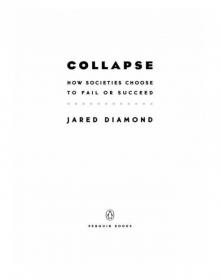 Collapse: How Societies Choose to Fail or Succeed
Collapse: How Societies Choose to Fail or Succeed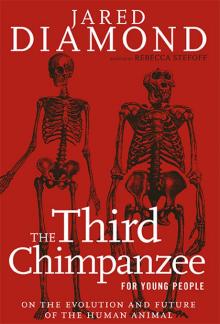 The Third Chimpanzee: The Evolution and Future of the Human Animal
The Third Chimpanzee: The Evolution and Future of the Human Animal The World Until Yesterday: What Can We Learn From Traditional Societies?
The World Until Yesterday: What Can We Learn From Traditional Societies?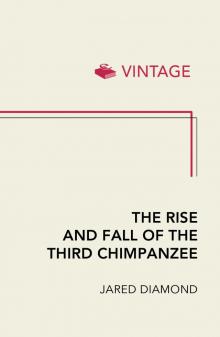 The Rise and Fall of the Third Chimpanzee
The Rise and Fall of the Third Chimpanzee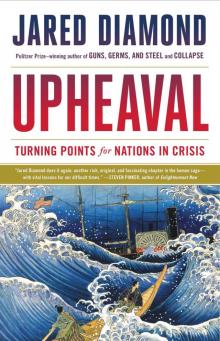 Upheaval: Turning Points for Nations in Crisis
Upheaval: Turning Points for Nations in Crisis Guns, Germs, and Steel
Guns, Germs, and Steel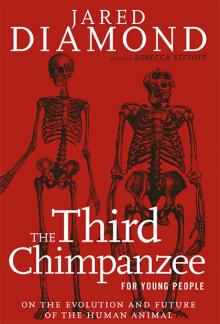 The Third Chimpanzee for Young People
The Third Chimpanzee for Young People Why Is Sex Fun?
Why Is Sex Fun?